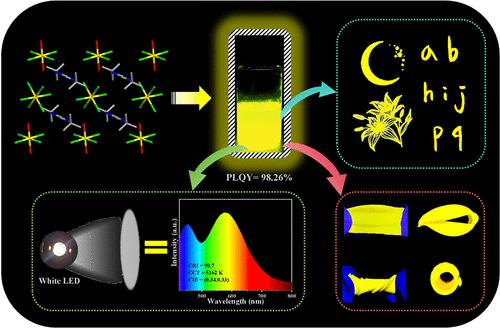用于高效发光墨水和白光发光二极管的具有近穷光量子产率的有机卤化铟
IF 8.2
2区 材料科学
Q1 MATERIALS SCIENCE, MULTIDISCIPLINARY
引用次数: 0
摘要
零维有机卤化铟作为一种极具前景的宽带发光材料,具有广阔的应用前景,但目前大多数卤化铟存在光致发光量子产率低的问题,需要高功率的激发光源才能获得理想的性能。在这项工作中,我们精心选择合适的有机阳离子作为晶体结构工程,获得了一系列高效的0D溴化铟。在紫外光激发下,这些0D卤化铟显示出宽带黄光发射(550 - 600nm),具有接近统一的plqy,是先前报道的所有卤化铟中最高的值之一。得益于成功的纳米工程,将纳米晶体分散到各种有机溶剂中,可以很容易地制备出基于这些0D卤化铟的高发光油墨。该发光油墨可用于印刷各种防伪图案,在紫外和可见光的交替照射下呈现可见/不可见转换的光可逆切换。此外,利用这些0D卤化物作为下转换荧光粉,可以制备出显色指数在90以上的白光二极管。这项工作不仅促进了卤化铟的发展,而且大大拓宽了卤化铟在固态照明和防伪等方面的应用。本文章由计算机程序翻译,如有差异,请以英文原文为准。

Organic Indium Halides with Near-Unity Photoluminescence Quantum Yields for Highly Efficient Luminescent Inks and White Light Emitting Diodes
Zero-dimensional (0D) organic indium halides have been emerged as promising broadband light emitters with wide application prospects, but most of the present halides suffer from low photoluminescence quantum yield (PLQY), and a high-power excitation light source is needed to obtain desirable performance. In this work, we elaborately select appropriate organic cations as crystal structural engineering and obtained a series of highly efficient 0D indium bromides. Under UV light excitation, these 0D indium halides display broadband yellow light emissions (550–600 nm) with near-unity PLQYs, which represents one of the highest values in all the previously reported indium halides. Benefiting from successful nanoscale engineering, highly luminescent inks based on these 0D indium halides are facilely prepared by dispersing nanocrystals into various organic solvents. The luminescent ink can be utilized to print various anticounterfeiting patterns, which displays photoreversible switching with visible/invisible transformation under the alternating irradiation of UV and visible light. Furthermore, white light emitting diodes can be fabricated with high color rendering index above 90 by using these 0D halides as down-conversion phosphors. This work not only promotes the development of indium halides but also significantly broadens the application in solid-state illumination and anticounterfeiting, etc.
求助全文
通过发布文献求助,成功后即可免费获取论文全文。
去求助
来源期刊

ACS Applied Materials & Interfaces
工程技术-材料科学:综合
CiteScore
16.00
自引率
6.30%
发文量
4978
审稿时长
1.8 months
期刊介绍:
ACS Applied Materials & Interfaces is a leading interdisciplinary journal that brings together chemists, engineers, physicists, and biologists to explore the development and utilization of newly-discovered materials and interfacial processes for specific applications. Our journal has experienced remarkable growth since its establishment in 2009, both in terms of the number of articles published and the impact of the research showcased. We are proud to foster a truly global community, with the majority of published articles originating from outside the United States, reflecting the rapid growth of applied research worldwide.
 求助内容:
求助内容: 应助结果提醒方式:
应助结果提醒方式:


